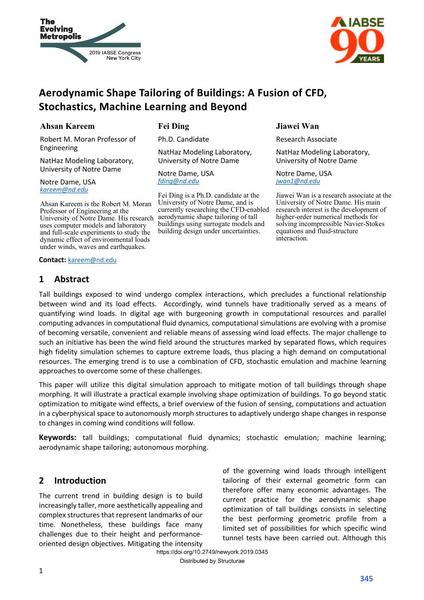Aerodynamic Shape Tailoring of Buildings: A Fusion of CFD, Stochastics, Machine Learning and Beyond

|
|
|||||||||||
Détails bibliographiques
| Auteur(s): |
Ahsan Kareem
(NatHaz Modeling Laboratory, University of Notre Dame)
Fei Ding (NatHaz Modeling Laboratory, University of Notre Dame) Jiawei Wan (NatHaz Modeling Laboratory, University of Notre Dame) |
||||
|---|---|---|---|---|---|
| Médium: | papier de conférence | ||||
| Langue(s): | anglais | ||||
| Conférence: | IABSE Congress: The Evolving Metropolis, New York, NY, USA, 4-6 September 2019 | ||||
| Publié dans: | The Evolving Metropolis | ||||
|
|||||
| Page(s): | 345-351 | ||||
| Nombre total de pages (du PDF): | 7 | ||||
| DOI: | 10.2749/newyork.2019.0345 | ||||
| Abstrait: |
Tall buildings exposed to wind undergo complex interactions, which precludes a functional relationship between wind and ist load effects. Accordingly, wind tunnels have traditionally served as a means of quantifying wind loads. In digital age with burgeoning growth in computational resources and parallel computing advances in computational fluid dynamics, computational simulations are evolving with a promise of becoming versatile, convenient and reliable means of assessing wind load effects. The major challenge to such an initiative has been the wind field around the structures marked by separated flows, which requires high fidelity simulation schemes to capture extreme loads, thus placing a high demand on computational resources. The emerging trend is to use a combination of CFD, stochastic emulation and machine learning approaches to overcome some of these challenges. This paper will utilize this digital simulation approach to mitigate motion of tall buildings through shape morphing. It will illustrate a practical example involving shape optimization of buildings. To go beyond static optimization to mitigate wind effects, a brief overview of the fusion of sensing, computations and actuation in a cyberphysical space to autonomously morph structures to adaptively undergo shape changes in response to changes in coming wind conditions will follow. |
||||
